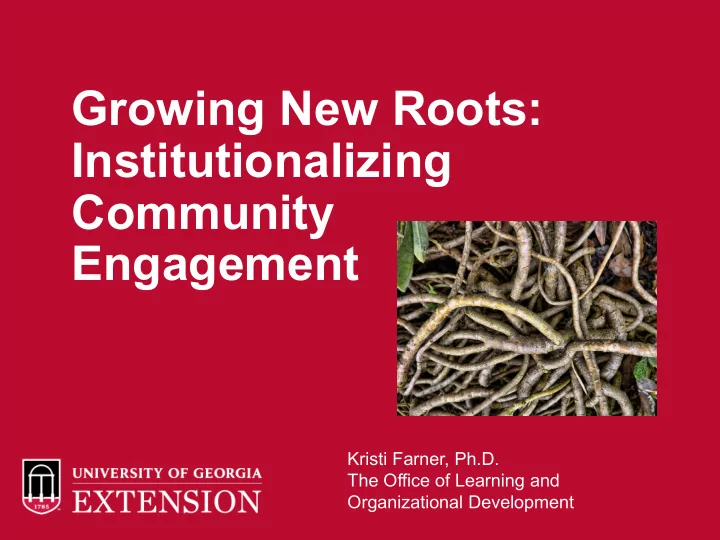

Growing New Roots: Institutionalizing Community Engagement Kristi Farner, Ph.D. The Office of Learning and Organizational Development
2 Problem • Many higher education institutions use community engagement as a way to partner with communities to collaboratively address pressing societal needs. • Institutionalizing community engagement in a higher education institution is complex.
3 Study Purpose To describe and understand how leaders at a selected university enacted the institutionalization of community engagement
The Study Aimed to… Examined how one university progressed toward incorporating community engagement into their • norms • values • day-to-day work
Drawing from the field: Theoretical Base • Individual Level = Weerts and Sandmann’s (2010) boundary-spanning framework • Organizational Level = Holland’s (2006) assessment matrix for institutionalizing community • Interplay between levels: Adaptive Challenge (Heifetz & Laurie, 2001)
Literature Review Concept Design Topics The purpose of this study was to • • University leaders Participants explored leaders’ perceptions • of the nature of boundary- Lens to analyze data for • Boundary spanning spanning activities research question two • Lens to analyze data for • and the complexity Adaptive challenges research question three • of how the university Context for case study • • operationalized the Institutionalization Lens to analyze data for institutionalization theory research question one • Lens to analyze data for • of community engagement Community engagement research question two
Gap in the literature: A new conceptual model was needed to represent the interplay of individual and organizational factors in the institutionalization of community engagement in higher education institutions.
Adaptive Challenges • Do not have straightforward solutions • Systematic • Involve multiple stakeholders (Heifetz & Laurie, 2001)
Change Agents Consider the change agents needed to influence this change. Individuals who can negotiate: • Power • Information • Relationships (Torres et al., 2013)
Institutionalization Transforming the change from a peripheral activity to a fully integrated method of strategy and practice. (Holland, 2009)
11 Research Questions 1. What are key characteristics of the institutionalization of community engagement? 2. According to university leaders, what qualities do community engagement boundary spanners possess? 3. In what ways do university leaders address the institutionalization of community engagement as an adaptive challenge?
Methodology Travel Qualitative, single-case study • Selection criteria: • Held the Carnegie Foundation for the • Advancement of Teaching Community Engagement Classification Participants continually attend the • Engagement Academy for University Leaders
Data Sources • University artifacts • open-ended survey questions • transcripts from focus groups and semi- structured interviews
14 Findings • Organizational Level • Incubator for innovation in community engagement • Building a coalition of the willing • Individual Level • Action over rhetoric • Building a coalition of the willing • Address adaptive challenges • Empowering others to stretch beyond routines and question norms • Shaping institutional norms • Role complexity and leadership
Adaptive Braid of Institutionalization
Institutional Factors Mission • • Leadership • Promotion, Tenure, Hiring • Organizational Structure & Funding • Student Involvement • Faculty Involvement • Community Involvement External Communications& Fundraising • (Holland, 2006)
Example
References Holland, B. A. (2006). Levels of commitment to community engagement, characterized by key organizational factors evidencing relevance to institutional mission. Retrieved from http://www.henceonline.org/resources/institutional Holland, B. A. (2009). Will it last? Evidence of institutionalization at Carnegie classified community engagement institutions. New Directions for Higher Education, 2009(147), 47-54. Heifetz, R. A., & Laurie, D. L. (2001). The work of leadership. Harvard Business Review, 79(11), 5-15. Torres, V., Viterito, A., Heeter, A., Hernandez, E., Santiague, L., & Johnson, S. (2013). Sustaining Opportunity in Rural Community Colleges. Community College Journal of Research and Practice. 37: 3–17. Weerts, D. J., & Sandmann, L.R. (2010). Community engagement and boundary- spanning roles at research universities. Journal of Higher Education, 6, 632-637.
Questions? Want more information? Farner, K. (2019). Institutionalizing Community Engagement in Higher Education: A Case Study of Processes Toward Engagement. Journal of Higher Education, Outreach, and Engagement 23(2): 147 – 152. Kristi Farner kfarner@uga.edu
Recommend
More recommend